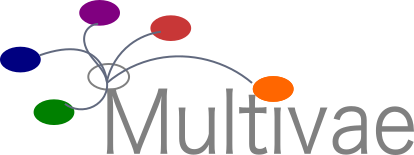This library implements some of the most common Multimodal Variational Autoencoders methods in a unifying framework for effective benchmarking and development. You can find the list of implemented models below. It includes ready to use datasets like MnistSvhn 🔢, CelebA 😎 and PolyMNIST, and the most used metrics : Coherences, Likelihoods and FID. It integrates model monitoring with Wandb and a quick way to save/load model from HuggingFaceHub🤗.
Install the library by running:
pip install multivaeor by cloning the repository:
git clone https://github.com/AgatheSenellart/MultiVae.git
cd MultiVae
pip install .Cloning the repository gives you access to tutorial notebooks and scripts in the 'example' folder.
Load a dataset easily:
from multivae.data.datasets import MnistSvhn
train_set = MnistSvhn(data_path='your_data_path', split="train", download=True)Instantiate your favorite model:
from multivae.models import MVTCAE, MVTCAEConfig
model_config = MVTCAEConfig(
latent_dim=20,
input_dims = {'mnist' : (1,28,28),'svhn' : (3,32,32)})
model = MVTCAE(model_config)Define a trainer and train the model !
from multivae.trainers import BaseTrainer, BaseTrainerConfig
training_config = BaseTrainerConfig(
learning_rate=1e-3,
num_epochs=30
)
trainer = BaseTrainer(
model=model,
train_dataset=train_set,
training_config=training_config,
)
trainer.train()See https://multivae.readthedocs.io
Several examples are provided in examples/ - as well as tutorial notebooks on how to use the main features of MultiVae(training, metrics, samplers) in the folder examples/tutorial_notebooks. As an introduction to the package, see the getting_started.ipynb notebook.
- Models available
- Quickstart
- Table of Contents
- Installation
- Usage
- Contribute
- Reproducibility statement
- Citation
git clone https://github.com/AgatheSenellart/MultiVae.git
cd MultiVae
pip install .Our library allows you to use any of the models with custom configuration, encoders and decoders architectures and datasets easily. See our tutorial Notebook at /examples/tutorial_notebooks/getting_started.ipynb to easily get the gist of principal features.
If you want to contribute to the project, for instance by adding models to the library: clone the repository and install it in editable mode by using the -e option
pip install -e .In order to propose a contribution, you can follow the guidelines in CONTRIBUTING.md file. Detailed tutorials are provided on how to implement a new model, sampler, metrics or dataset.
Most implemented models are validated by reproducing a key result of the paper.
If you have used our package in your research, please consider citing our paper presenting the package :
MultiVae : A Python library for Multimodal Generative Autoencoders (2023, Agathe Senellart, Clément Chadebec and Stéphanie Allassonnière)
Bibtex entry :
@preprint{senellart:hal-04207151,
TITLE = {{MultiVae: A Python library for Multimodal Generative Autoencoders}},
AUTHOR = {Senellart, Agathe and Chadebec, Clement and Allassonniere, Stephanie},
URL = {https://hal.science/hal-04207151},
YEAR = {2023},
}




